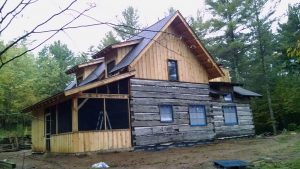 Most pioneer cabins started as small structures so they could be completed quickly before the next winter settled in. Most were about 16 to 20 feet wide and 24 to 30 feet long with a one and a half story design so the second floor could be used for bedrooms in the smaller cabins. As the young family grew some cabins were added onto while others just seemed more crowded. The one thing that seemed to cause more additions on more cabins was when indoor plumbing was discovered and the bathroom was invented.
Most pioneer cabins started as small structures so they could be completed quickly before the next winter settled in. Most were about 16 to 20 feet wide and 24 to 30 feet long with a one and a half story design so the second floor could be used for bedrooms in the smaller cabins. As the young family grew some cabins were added onto while others just seemed more crowded. The one thing that seemed to cause more additions on more cabins was when indoor plumbing was discovered and the bathroom was invented.
This often resulted in the addition of a kitchen as well as the bathroom and aside from the extra space and convenience that the new addition brought with it it almost always was conventionally framed and covered with clapboard. Most pioneers took this opportunity to side over the cabin to seal out the wind and the rain which also made the old log cabin look more like the new homes being built at that time.
 Although they didn’t realize it at the time this simple siding project would be the single most important reason for the survival of these log cabins because they added a layer of protection that was actually better than any of the stains and chinking that we use today in the restoration process. So if history shows the cabin was protected with siding for three or four times longer than when the logs were exposed does restoration really mean that brief part of its history or the longest period with the siding protecting the logs. Considering the higher maintenance and lower energy efficiency of some log cabins maybe those old pioneers where onto something we should look into.
Although they didn’t realize it at the time this simple siding project would be the single most important reason for the survival of these log cabins because they added a layer of protection that was actually better than any of the stains and chinking that we use today in the restoration process. So if history shows the cabin was protected with siding for three or four times longer than when the logs were exposed does restoration really mean that brief part of its history or the longest period with the siding protecting the logs. Considering the higher maintenance and lower energy efficiency of some log cabins maybe those old pioneers where onto something we should look into.
